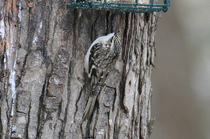California creeper
Adults are brown on the upperparts with light spotting, resembling a piece of tree bark, with white underparts. They have a long thin bill with a slight downward curve and a long tail. The male creeper has a slightly larger bill than the female. The Brown creeper is 11.7-13.5 cm long .
The California creeper is classified as Least Concern. Does not qualify for a more at risk category. Widespread and abundant taxa are included in this category.
California creeper, common creeper, little brown creeper, Mexican creeper, Rocky Mountain creeper, Sierra creeper and tree creeper. Range: Breeding occurs from Alaska through Ontario to Newfoundland, south throughout the western mountains, the Great Lakes area and New England. Winters are spent in much of their breeding range south to the Gulf Coast and Florida. Brown creepers occupy all coniferous forests and woodland habitats in Colorado from ponderosa pine to sub-alpine spruce/fir. More
, in which the California creeper was breeding quite commonly, together with several other interesting birds such as Oregon and chestnut-backed chickadees, western golden-crowned kinglets, and Audubon's warblers. It was a large tract of smooth, level, prairielike country that supported a fine open growth of large cedars, two or three species of firs, and a few scattering oaks. Ridgway (1904) called this the tawny creeper, an appropriate name, also used by others. He says that it is "similar to C. f. More

Original source: Dave Govoni
Author: Dave Govoni
Permission: Some rights reserved
Family : Certhiidae
Genus : Certhia
Species : americana
Authority : Bonaparte, 1838
